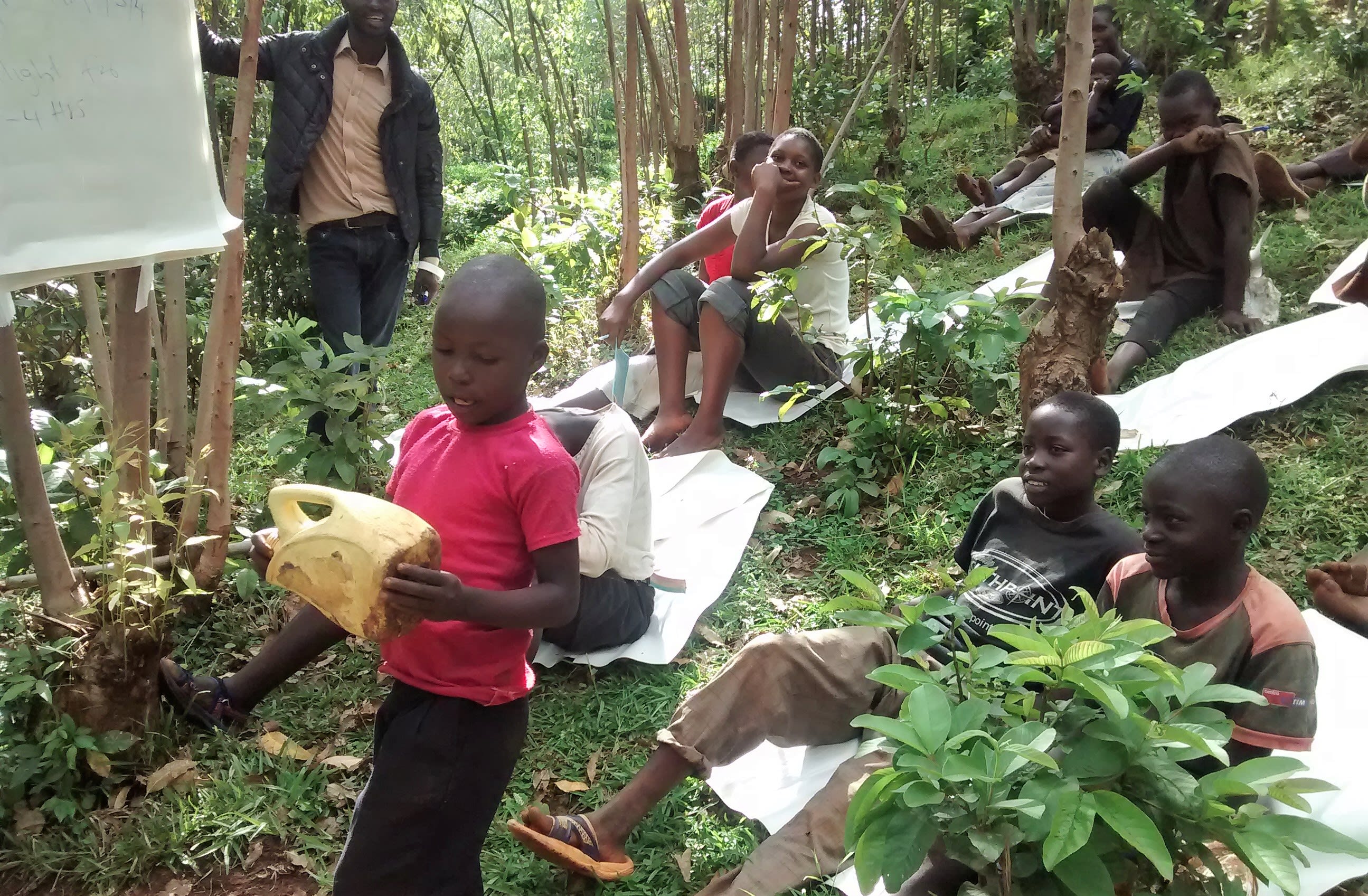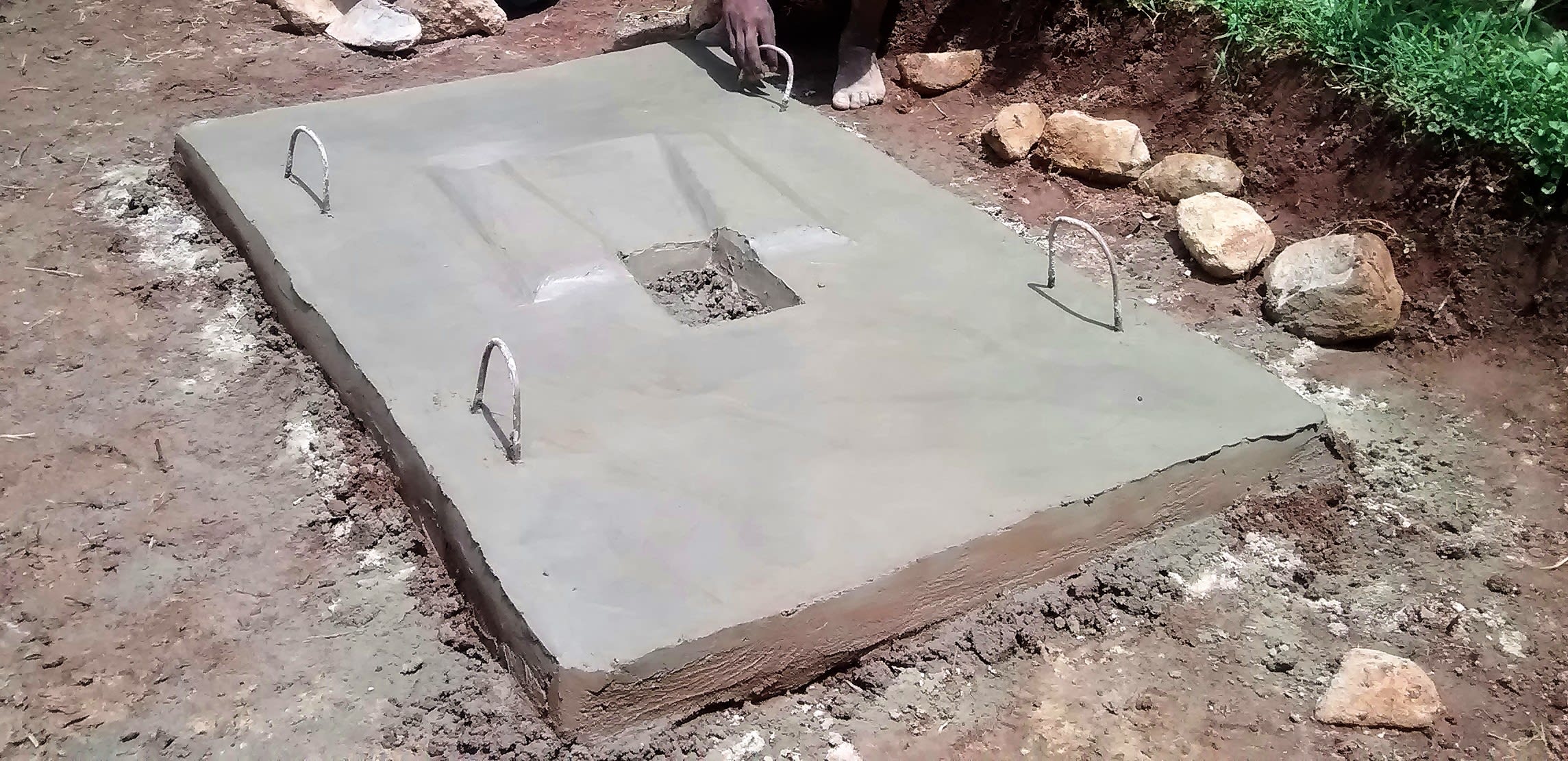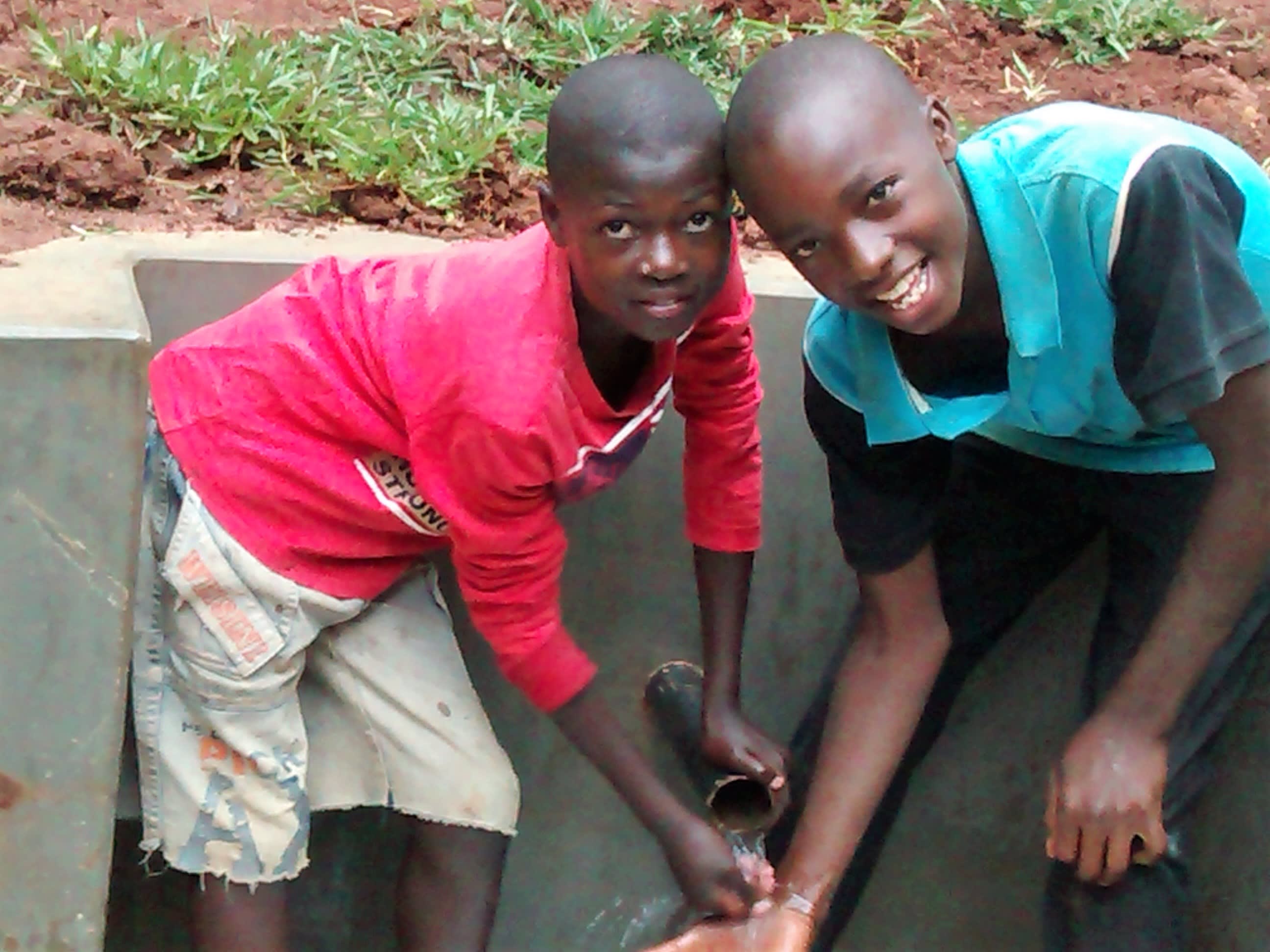July, 2020: COVID-19 Prevention Training Update at Wamuhila Community, Isabwa Spring
Our teams are working on the frontlines of the COVID-19 pandemic. Join us in our fight against the virus while maintaining access to clean, reliable water.

A trainer fills the handwashing station with water for practical demonstrations
We are carrying out awareness and prevention trainings on the virus in every community we serve. Very often, our teams are the first (and only) to bring news and information of the virus to rural communities like Wamuhila, Kenya.
We trained more than 26 people on the symptoms, transmission routes, and prevention of COVID-19. Due to public gathering concerns, we worked with trusted community leaders to gather a select group of community members who would then relay the information learned to the rest of their family and friends.

Handwashing with a smile
We covered essential hygiene lessons:
- Demonstrations on how to build a simple handwashing station
- Proper handwashing technique
- The importance of using soap and clean water for handwashing
- Cleaning and disinfecting commonly touched surfaces including at the water point.

Showing the COVID-19 informational pamphlet received at training
We covered COVID-19-specific guidance in line with national and international standards:
- Information on the symptoms and transmission routes of COVID-19
- What social distancing is and how to practice it
- How to cough into an elbow
- Alternative ways to greet people without handshakes, fist bumps, etc.
- How to make and properly wear a facemask.

Homemade mask tutorial with Trainer Patience
During training, we installed a new handwashing station with soap near the community’s water point, along with a sign with reminders of what we covered.
Due to the rampant spread of misinformation about COVID-19, we also dedicated time to a question and answer session to help debunk rumors about the disease and provide extra information where needed.

Fitting the mask made during training on a child for her to keep
"To the participants, it was a blessing to have training officers all the way from Kakamega to Vihiga County just to train them on Coronavirus. They agreed to make it a habit to wash hands every now and then using soap with running water. They also accepted to make face masks locally and wear them when they go out of their homes. To add on that, they agreed to stay at least 1 meter apart from one another, and finally they all agreed to sneeze in their flexed elbows," recalled Trainer Patience Njeri.

Reviewing the prevention reminders chart
We continue to stay in touch with this community as the pandemic progresses. We want to ensure their water point remains functional and their community stays informed about the virus.

Cough and sneeze into the elbow
Water access, sanitation, and hygiene are at the crux of disease prevention. You can directly support our work on the frontlines of COVID-19 prevention in all of the communities we serve while maintaining their access to safe, clean, and reliable water.

September, 2017: Wamuhila Community Project Complete
Isabwa Spring in Wamuhila Community, Kenya is now a protected, clean source of water thanks to your donation. The spring is protected from contamination, five sanitation platforms have been provided for the community, and training has been given in sanitation and hygiene. Imagine the changes that all of these resources are going to bring for these residents! You made it happen! Now, want to do a bit more? Join our team of monthly donors and help us maintain this spring protection and many other projects.
We just updated the project page with the latest pictures, so make sure to check them out! And please enjoy the rest of the report from our partner in Kenya:
Project Result: New Knowledge
We worked with Village Elder Nazan Mafao to get people to attend training. He insisted that at least one person from every household be there, but three ended up not being able to make it because of a death in the family. One of these families had lost their teenage daughter who misused birth control pills, and were burying her on that very day (Editor's Note: We desperately wish we had been in time for her to attend our training on family planning). However, Elder Mafao was so zealous about hygiene and sanitation that he committed to meet with them at their return and relay all of the information.
A cluster of trees nearby Isabwa Spring provided comfortable shade for the participants to sit under. They used some of our poster paper to spread out on the ground to protect them from the dew. Normally, we carry a table from a local home to use as an easel for our flip charts, but it was much too steep where we met. Instead, we pinned our pictures and posters up on trees.

Everyone including the children arrived on time, with the children most excited to be involved. They always scrambled to be the first for demonstrations, and even stayed behind to get extra time with our trainers. They followed us after, asking to be photographed showing off their mastery of hand-washing! They ran back to the village bragging that their pictures would be sent back to America.

These children are excited to show you their hand-washing skills!
Training topics included but were not limited to leadership and governance; operation and maintenance of the spring; healthcare; family planning; immunizations; the spread of disease and prevention. We also covered water treatment methods, environmental hygiene, and hygiene promotion. We also took a session to emphasize proper maintenance of the spring protection project. The community should refrain from washing clothes, watering animals, farming with fertilizers, and open defecation in the vicinity.
Our poster paper and illustrations facilitated presentations on healthy and unhealthy behaviors. Group discussions were also very effective in helping participants take responsibility for what they were learning. And since we were at the spring, we could easily show the group how to manage and maintain their new clean water point.

Little Patrick explains how his mom currently washes out their water containers.
28-year-old Rachael Ambuso said that "this is the kind of knowledge we have lacked for so long! The funny thing is that we did not even know that there were a lot of very important messages we were lacking, henceforth we shall welcome whoever comes to our village with the intention of educating us, no matter the area of interest."
Project Result: Sanitation Platforms
All five sanitation platforms have been installed and are ready for use. These five families are happy about this milestone and are optimistic that there will be much less open defecation. People without proper latrines would often use the privacy of bushes, but now have a private place of their own. It is expected that proper use of latrine facilities provided by the sanitation platforms will go a long way in reducing environmental pollution here. We will continue to encourage these five families to finish building walls and roofs for privacy.

This sanitation platform now needs walls, a door, and a roof! The family will build the superstructure with materials that are affordable for them.
Project Result: Spring Protection
Community members provided all locally available construction materials, e.g bricks, wheelbarrows of clean sand, wheelbarrows of ballast, fencing poles and hard core (crushed rock and gravel). Accommodation and food for the artisan were provided and a few people volunteered their services as laborers.

Mr. Anziva spent a couple of days helping the artisan protect Isabwa Spring.
The spring area was excavated to create space for setting the foundation of polythene, wire mesh and concrete. After the base had been set, both wing walls and the head wall were set in place using brickwork. The discharge pipe was fixed low in place through the head wall to direct the water from the reservoir to the drawing area.
As the wing walls and head wall were curing, the stairs were set and the tiles were fixed directly below the discharge pipe. This reduces the erosive force of the falling water and beautifies the spring. The process of plastering the head wall and wing walls on both sides reinforces the brickwork and prevents water from the reservoir from seeping through the walls and allows pressure to build in the collection box to push water up through the discharge pipe. Lastly, the base of the spring was plastered and the collection box was cleaned. The source area was filled up with clean hardcore and covered with a polythene membrane to eliminate any potential sources of contamination. Finally, grass was planted and cutoff drains dug to direct surface water away from the spring box.

The artisan working on stairs for easy access to clean water.
Heavy rains continuously interrupted construction; whenever working with cement, the artisan had to get traps to cover things up. This added a few extra days to the process. But perseverance soon gave the community a reason to celebrate: They now have clean water.

Rebecca Sayo was there, and she explained that she was shocked. "We have struggled and prayed for long to have clean water in our village, but hope was lost along the way after being disappointed several times. But when you reached here and said that we should look for the local materials (sand, stones, and bricks) I tended to believe them as they wanted us to participate – that is the only hope I hanged on to. You disappeared after doing the baseline for about two months and I started thinking to myself that you were just like the rest. After that short but seemingly long wait, materials came and just within three days our spring is already protected; I wonder at how God works! Thank you for supporting us, we cannot make you understand the depth of our gratitude, but God who sees our hearts really knows that this is a rescue to many!" she exclaimed.
There are dozens more people now coming to get clean water from the spring than the we anticipated. It appears that some families were evading us so they wouldn't have to help gather materials and help our artisans. They were walking many miles just to fetch water from another community. The water user committee is standing up for their water point, telling these truants that they are not allowed to draw water from Isabwa Spring until they contribute 300 shillings to save for spring protection maintenance. The account already has 1,800 saved! We share this with great joy as this is evidence the community will jealously protect and maintain their new source of clean water. This is sustainable development!




 Rehabilitation Project
Rehabilitation Project







































